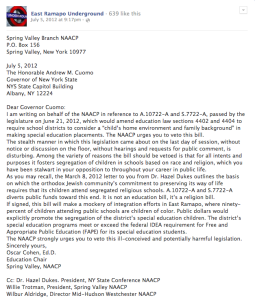A community made up of approximately 65% white, 21% black, 4.3% Asian, 6.8% other, and 2.4% multi-racial, Ramapo has long been seen by the NAACP as powder keg ready to explode.
In East Ramapo, the community is arguably divided against those racial lines. On one hand, the population that uses the public school system is largely made up of those of African American and Hispanic descent; on the other, the majority rests with the Hasidic and ultra-Orthodox religious groups, who run the Board of Education, but send their children to private religious institutions. As a result of these tensions, East Ramapo officials have been bombarded with numerous accusations, ranging from segregating the religious special education students from public school students to using Title I and III funds to finance private religious schools.
Numerous attempts by the civil rights organization – and others – to call attention to the school district have gone unheeded.
 In July 2012, the local NAACP wrote to Gov. Cuomo, asking him to veto a bill that allows school districts to consider a child’s home environment and family background when making special education placements. The organization said that this bill would “make a mockery of integration efforts” in East Ramapo.
In July 2012, the local NAACP wrote to Gov. Cuomo, asking him to veto a bill that allows school districts to consider a child’s home environment and family background when making special education placements. The organization said that this bill would “make a mockery of integration efforts” in East Ramapo.
This has noticeably changed in recent months. In 2012, a not-for-profit law firm, Advocates for Justice, filed a lawsuit and an administrative complaint against the school board and in September, the judge allowed it to move forward.
[SLIDESHOW: “Lawsuits upon lawsuits”]
However, racial and religious tensions are arguably still at an all-time high, say activists.
In the summer of 2011, an 11-year old girl became involved in a so-called brawl after she accidently hit a vehicle with a water balloon. A large group of Orthodox men allegedly confronted the girl and her family until two men were ultimately arrested, reported News12 Hudson Valley.
Police told the news station that they didn’t believe it to be racially motivated.
Still, what makes some in the hyper-religious community so volatile against others and willing to demonstrate a lack of respect to the laws and customs of the community at large?
Samuel Heilman, a professor of sociology at the City University of New York’s Queens College, says that the answer to this question lies in the religious sect’s belief in insiders and outsiders.
“In almost every domain of their lives they live by very, very stringent rules,” Heilman told the Jewish Daily Forward. “But those aspects of life that don’t deal with those stringent rules, there they feel they can be a lot more cavalier.”
Tension flare-ups are not only reserved for those outside the religious community. In August, two Hasidic men were sprayed with paintballs from a moving car. While driving away, one witness heard them shout an anti-Semitic slur. Three suspects were later arrested and charged with second-degree hate crime, reported the Rockland County Times.
Rev. Weldon McWilliams IV did not condone the violence, but told the weekly paper that the incident exposed a need for both communities to work together towards a common goal.
“We can’t coexist under the current conditions,” McWilliams told Rockland County Times.
Not racial, but ‘ideological’
Unlike so many others, Olivia Castor, one of the co-founders of the East Ramapo Student Coalition and currently a freshman at Harvard University, argued that race does not play a role in the East Ramapo School District.
“The religious community has one definition of education and the public school has one definition of education. And those differences are so great that they create tension within a school district that is contributing to all these problems,” Castor said. “So there’s a tension, but I wouldn’t call it religious tension. I would call it an ideological [tension] – or the definition of education is different between the two communities. “
[MORE: “ERCSD Students fight back”]
According to Castor, the problem stems specifically from education, but is largely perpetuated by the differences in religion. The religious community has certain approaches and certain beliefs that – when it comes to race – the public school community does not hold.
“The reason for this difference is because of religious differences, school differences, [and] racial differences, but the main problem is that there is a difference in education. That’s not something that is going to be reconciled,” she explained.
In response to Assemblyman Zebrowski’s proposed study, by splitting both the private and public schools into separate districts, you are effectively creating racial tension – even more than before.
[MORE: “East Ramapo, once a ‘great’ district, now a district divided”]
“Basically, it just reminds me of a separate but equal thing and it’s never really equal,” Castor said. “The problem is the inability to work out your problems in a way so that you give up concessions, but the concessions are parallel for both groups. This is not going to be addressed.”
Leave a Reply